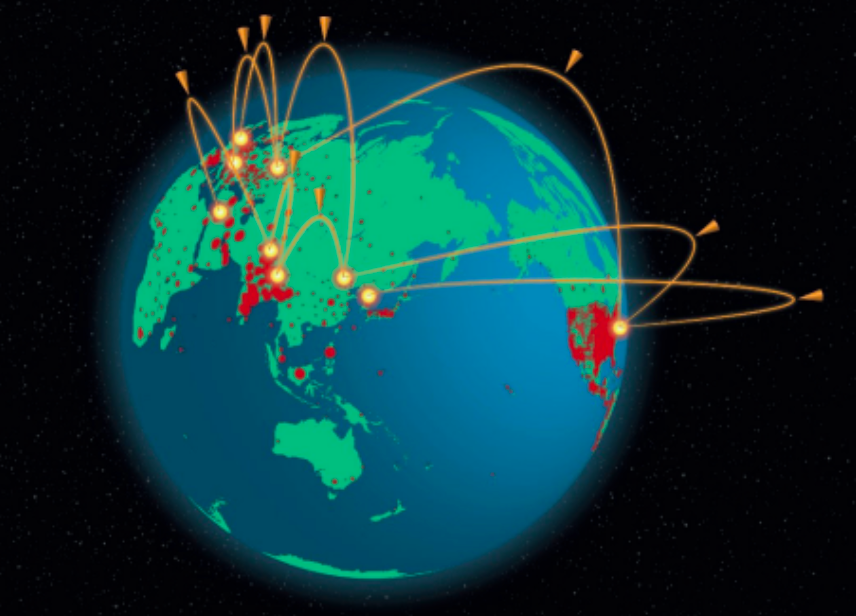THERESA HITCHENS

WASHINGTON: Two-thirds of the world’s nuclear armed nations are in the Asia-Pacific region. Now, a new report warns that Nuclear command, control and communication (NC3) among the increasingly mistrustful powers if the Asia-Pacific are ripe for failure, creating elevated risks of nuclear war, whether by accident or as the result of uncontrollable escalation in conventional conflict.
The Asia-Pacific Leadership Network study, released today and provided to Breaking Defense in advance, finds that “serious incidents with the potential to escalate to nuclear war have occurred on average once every three years between nuclear-armed states and in each case NC3 has been integral to the cause of the crisis, contributing to the risk of possible nuclear use.”
The report, written by APNL research director Peter Hayes and titled “Nuclear Command, Control, Communications (NC3) in Asia-Pacific,” reviews in depth and compares/contrasts the NC3 systems of the six nuclear nations in the Pacific — the United States, Russia, China, India, Pakistan and North Korea — from types of sensors to communications systems to computers to organizational structure.
While the delivery systems and warheads of nuclear weapons are the systems that draw the most attention, “There is a reason, however, that David slung his stone into the forehead of Goliath rather than his musculature,” writes Hayes. “Without a head connected to a body, a nuclear force is useless. … (NC3) is perhaps the most critical element of making nuclear war.”
The study frets that Asian nuclear powers seem to be expanding nuclear forces and developing increasingly effective counter-NC3 forces at the same time, which comes with some dangerous side effects on perceptions of nuclear stability — particularly with regard to making a first strike seem more attractive.
Counter-NC3 capabilities include cyberattacks on systems, and interference with satellites providing strategic-level communications as well as infrared early warning and other remote sensing satellites used for keeping tabs on each other’s nuclear forces.
“Vulnerability of many parts of the NC3 system contributes to the risk of a nuclear war,” the report says.
The specter of cyberattacks on the complex NC3 network of radios, satellites, computers and terminals that link the president and other national security leaders to US nuclear forces has been on the minds of key Defense Department officials and lawmakers for several years. A provision added to the 2021 National Defense Authorization Act required DoD to craft a new plan for NC3 cybersecurity, based on findings of an annual classified DoD study mandated by Congress in the 2018 defense appropriations act.
Meanwhile, Strategic Command is undertaking a classified overhaul of the NC3 network to modernize and update the underlying technologies, as well as improve cyber defenses and develop new concepts of operation. That overhaul, called NC3 Next, is being rolled out in increments over time.
Despite increasing risks of nuclear miscalculations, APLN finds, there currently are no international standards or norms for safe and transparent NC3 operations — with the exception of the clause in Cold War-era US-Soviet/Russian nuclear arms treaties that proscribes interference with “national technical means” (i.e. satellites used for verifying treaty compliance). A study by Aerospace Corporation last year warned of increased risks to US satellites if the New START treaty with Russia is allowed to collapse, for example.
And, of course, those treaties were bilateral — and it is unclear whether China has a similar understanding of nuclear deterrence to that of the US and Russia, which despite increased tensions by and large understand each other’s strategic concerns and stress points. The same uncertainty over over India, Pakistan or the DPRK. As a result, dialogue between Chinese and American military leaders on nuclear weapons would be in the US interest and would serve to shore up “strategic stability,” Maj. Gen. Michael Lutton, commander of the 20th Air Force responsible for the US ICBM force, told the Mitchell Institute last month.
Thus, the APLN study recommends dialogue among the region’s nuclear powers be launched in earnest as soon as possible “on the legal standards and the minimal transparency standards against which NC3 performance can be measured.”
It also recommends the establishment of “modern nuclear hotlines” as “an urgent risk reduction measure.”
Finally, the study lays out the tenets of a possible code of conduct for NC3 operations, including:
Do not target the national high command of a nuclear weapons or nuclear armed state.
Do not co-locate nuclear weapons with one’s own high command post or early warning interpretation sites or sensors.
Do not mix/fuse/share nuclear and conventional communications systems.
Getting the six nuclear powers to agree to such language, however, seems like an extreme longshot — meaning the Pacific likely will remain a potential nuclear hotspot for the foreseeable future.
No comments:
Post a Comment